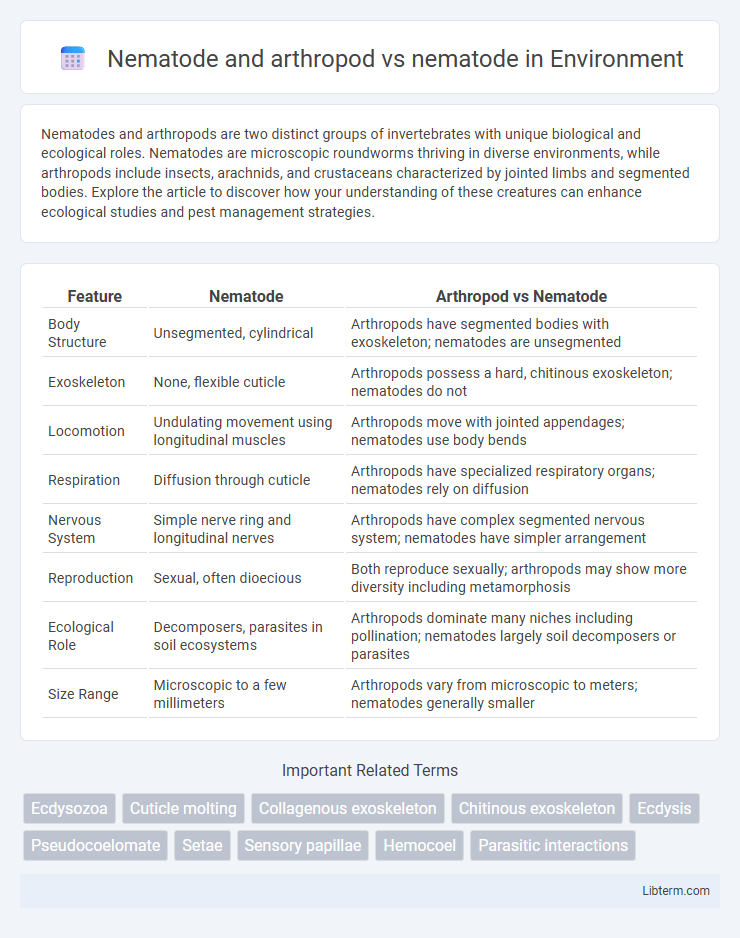Nematodes and arthropods are two distinct groups of invertebrates with unique biological and ecological roles. Nematodes are microscopic roundworms thriving in diverse environments, while arthropods include insects, arachnids, and crustaceans characterized by jointed limbs and segmented bodies. Explore the article to discover how your understanding of these creatures can enhance ecological studies and pest management strategies.
Table of Comparison
| Feature | Nematode | Arthropod vs Nematode |
|---|---|---|
| Body Structure | Unsegmented, cylindrical | Arthropods have segmented bodies with exoskeleton; nematodes are unsegmented |
| Exoskeleton | None, flexible cuticle | Arthropods possess a hard, chitinous exoskeleton; nematodes do not |
| Locomotion | Undulating movement using longitudinal muscles | Arthropods move with jointed appendages; nematodes use body bends |
| Respiration | Diffusion through cuticle | Arthropods have specialized respiratory organs; nematodes rely on diffusion |
| Nervous System | Simple nerve ring and longitudinal nerves | Arthropods have complex segmented nervous system; nematodes have simpler arrangement |
| Reproduction | Sexual, often dioecious | Both reproduce sexually; arthropods may show more diversity including metamorphosis |
| Ecological Role | Decomposers, parasites in soil ecosystems | Arthropods dominate many niches including pollination; nematodes largely soil decomposers or parasites |
| Size Range | Microscopic to a few millimeters | Arthropods vary from microscopic to meters; nematodes generally smaller |
Introduction to Nematodes and Arthropods
Nematodes, also known as roundworms, are unsegmented, cylindrical worms found in diverse environments, characterized by their simple body plan and a complete digestive system. Arthropods are segmented animals with exoskeletons made of chitin, jointed limbs, and bilateral symmetry, including insects, arachnids, and crustaceans. Both groups play crucial ecological roles, with nematodes often acting as decomposers or parasites, while arthropods contribute to pollination, soil aeration, and serve as key components in food webs.
Taxonomic Classification: Nematodes vs Arthropods
Nematodes belong to the phylum Nematoda, characterized by unsegmented, cylindrical bodies and a pseudocoelom, while arthropods are classified under the phylum Arthropoda, distinguished by segmented bodies, jointed appendages, and an exoskeleton made of chitin. Nematodes exhibit a simple body plan without specialized appendages, whereas arthropods have highly developed body segmentation and limb specialization facilitating diverse movement and ecological roles. Taxonomically, nematodes and arthropods diverge significantly due to differences in embryonic development, body cavity structure, and exoskeleton presence.
Morphological Differences Between Nematodes and Arthropods
Nematodes exhibit a simple, elongated, and unsegmented cylindrical body covered by a flexible cuticle, lacking appendages and specialized respiratory structures. In contrast, arthropods possess a segmented body divided into head, thorax, and abdomen, with jointed appendages, a rigid exoskeleton made of chitin, and specialized respiratory organs such as gills or tracheae. While nematodes have a pseudocoelom and rely on diffusion for gas exchange, arthropods feature a true coelom and complex circulatory systems supporting their diverse morphology and mobility.
Nematode Life Cycle and Adaptations
Nematodes exhibit a complex life cycle comprising egg, larval, and adult stages, with several molts before reaching maturity, allowing adaptation to diverse habitats, including soil, freshwater, and parasitic environments. Their cuticle provides protection against environmental stress and desiccation, supported by a hydrostatic skeleton enabling movement in tight spaces. Compared to arthropods, nematodes lack jointed appendages but have evolved specialized sensory structures and efficient reproductive strategies to thrive in varied ecological niches.
Arthropod Diversity and Adaptations
Arthropods exhibit unparalleled diversity and complex adaptations, including segmented bodies, exoskeletons made of chitin, and jointed appendages, which enable them to thrive in a wide range of environments from terrestrial to aquatic habitats. In contrast, nematodes possess simple, unsegmented cylindrical bodies with a flexible cuticle, adapted primarily for soil and parasitic lifestyles. Arthropods display advanced sensory organs and varied respiratory systems such as gills and tracheae, whereas nematodes rely on diffusion for gas exchange, highlighting the evolutionary innovations contributing to arthropod success.
Ecological Roles: Nematodes vs Arthropods
Nematodes play crucial roles in soil ecosystems as decomposers, nutrient recyclers, and regulators of microbial populations, impacting plant health and soil fertility. Arthropods, including insects, spiders, and crustaceans, contribute to pollination, predation, and organic matter breakdown, driving ecosystem dynamics and biodiversity. Both groups influence trophic interactions and nutrient cycles, but nematodes primarily operate at the microscopic level, while arthropods have broader ecological functions across terrestrial and aquatic habitats.
Interactions Between Nematodes and Arthropods
Nematodes and arthropods exhibit diverse interactions ranging from parasitism to mutualism, significantly impacting ecological dynamics and agricultural systems. Entomopathogenic nematodes specifically target arthropods as hosts, utilizing symbiotic bacteria to kill and consume insect pests effectively. These interactions influence population control, nutrient cycling, and biological pest management strategies in various ecosystems.
Parasitism: Nematodes Infecting Arthropods
Nematodes parasitizing arthropods represent a specialized interaction where nematodes exploit arthropods as hosts, affecting their physiology and behavior. Certain nematode species such as mermithids specifically infect insect hosts, causing developmental disruptions and often leading to host mortality. These parasitic relationships highlight complex ecological dynamics and potential applications in biological pest control targeting arthropod vectors.
Agricultural Impact: Nematodes and Arthropod Pests
Nematodes and arthropod pests both significantly affect agricultural productivity, but nematodes often cause root damage and nutrient depletion, leading to reduced crop yields. Arthropods, including insects and mites, primarily feed on plant tissues, spread diseases, and cause visible damage to crops. Integrated pest management strategies target both groups to minimize economic losses and enhance sustainable farming practices.
Key Differences: Nematode vs Nematode Comparison
Key differences between nematodes and arthropods lie in their body structure and segmentation: nematodes possess a cylindrical, unsegmented body with a pseudocoelom, whereas arthropods feature a segmented body with a true coelom and jointed appendages. Nematodes have a simple nervous system and lack specialized respiratory organs, while arthropods exhibit complex nervous systems and respiratory structures such as gills or tracheae. The exoskeleton of arthropods is chitinous and molted periodically, contrasting with the flexible, non-chitinous cuticle of nematodes.
Nematode and arthropod Infographic

 libterm.com
libterm.com